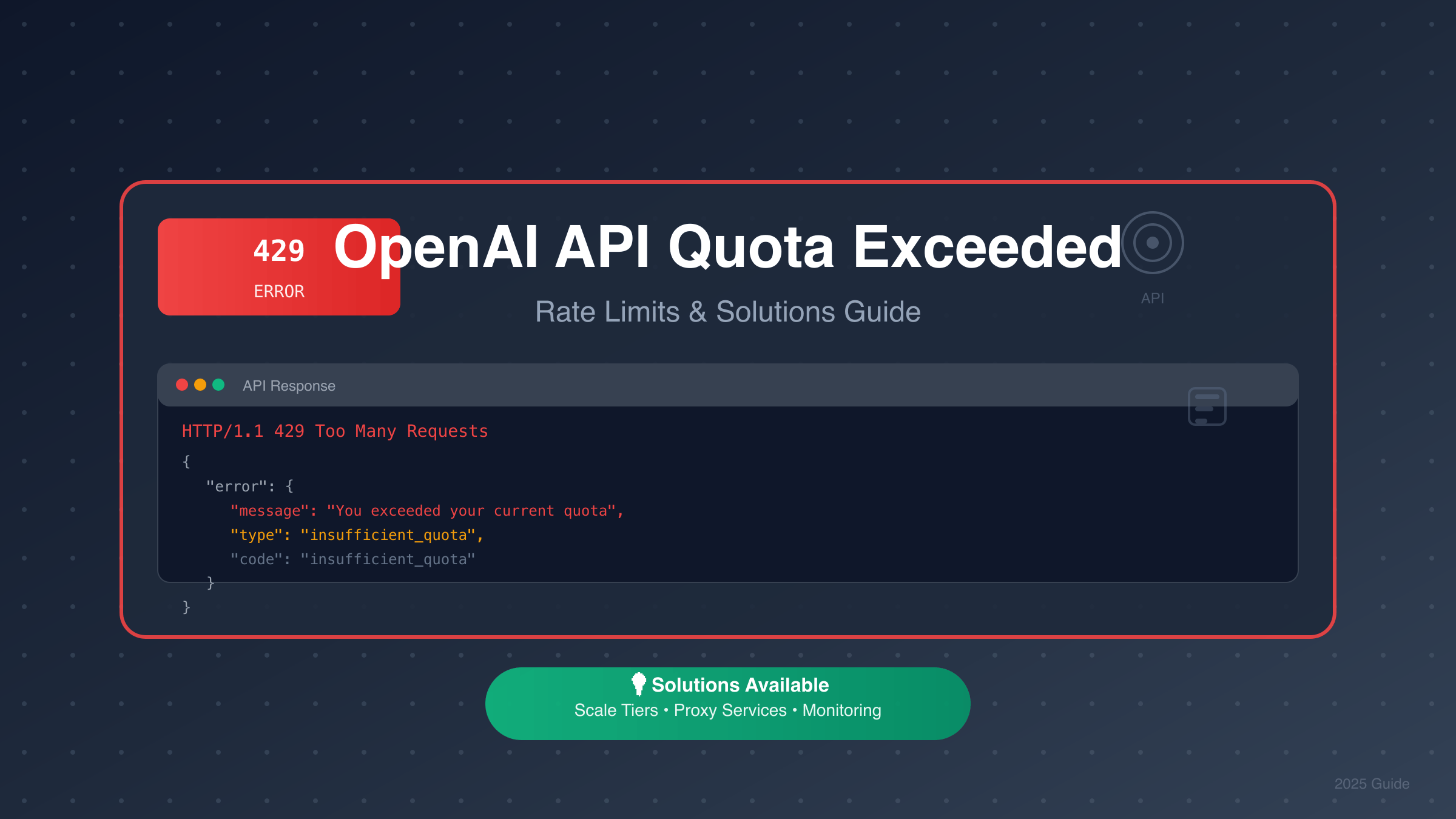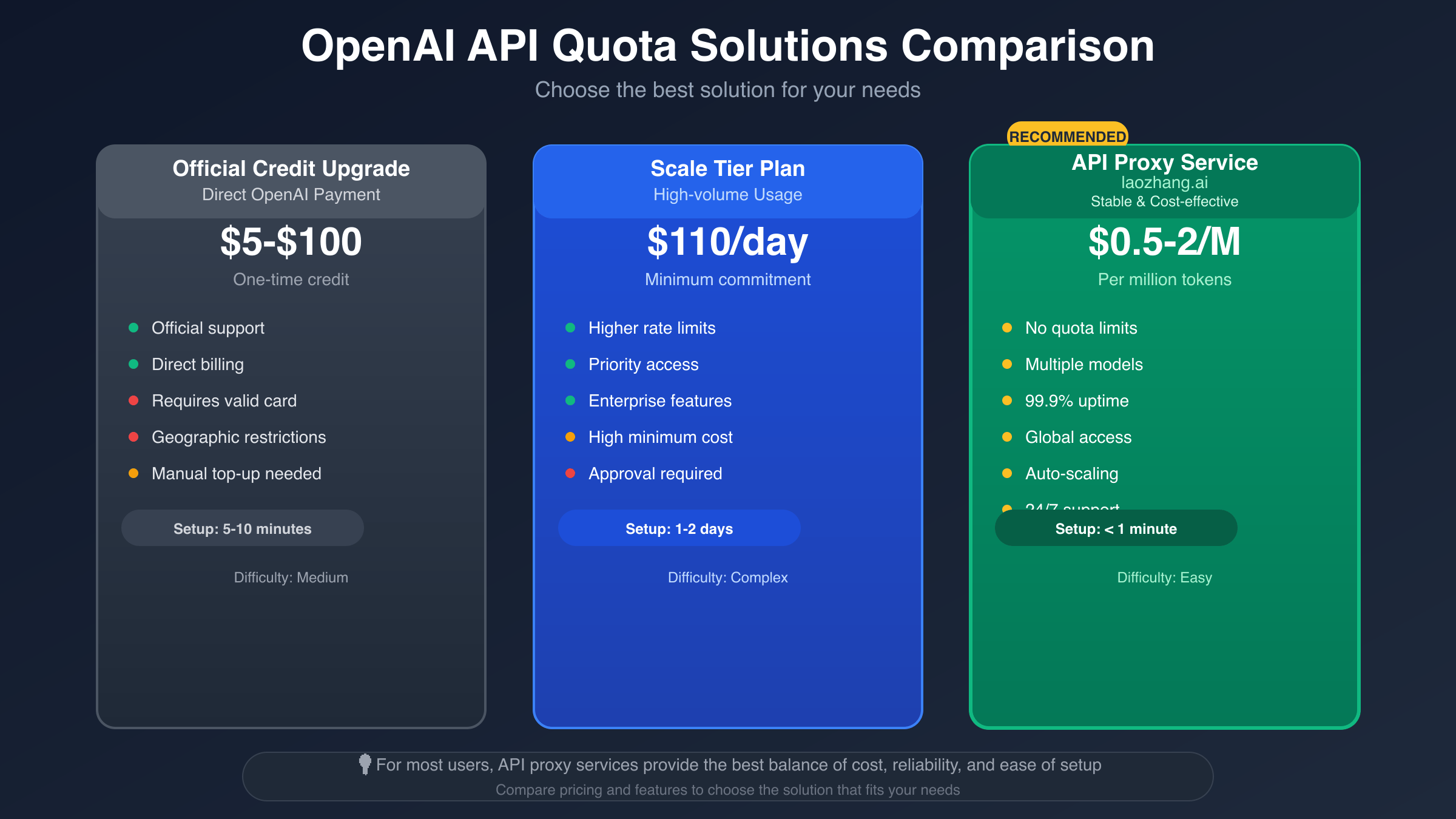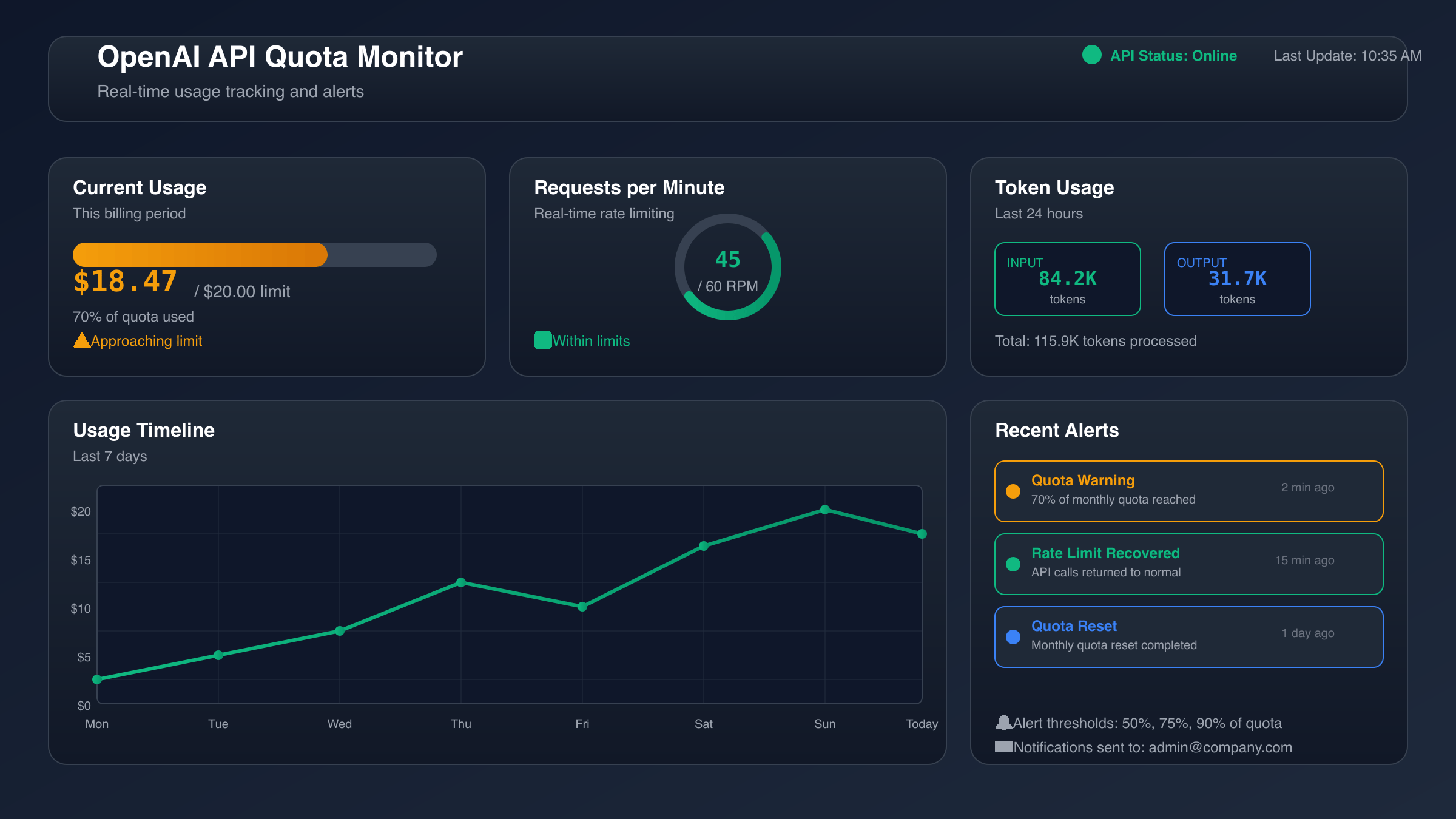The OpenAI API quota exceeded error (code 429) occurs when you exceed your account’s rate limits or run out of prepaid credits. Since OpenAI’s shift to prepaid billing in 2024, this error commonly appears when your balance reaches zero. The immediate solution is to add credits to your account or consider API proxy services like laozhang.ai for uninterrupted access.

Understanding OpenAI API 429 Error Types
The HTTP 429 error in OpenAI’s API system manifests in two distinct scenarios, each requiring different troubleshooting approaches. The first type, “insufficient_quota,” indicates billing or account limitations, while the second represents traditional rate limiting constraints.
Error code 429 with the message “You exceeded your current quota” typically appears when your account lacks sufficient prepaid credits or when free trial tokens have expired. This became more common after OpenAI’s February 2024 policy change, requiring all API users to maintain positive account balances before making requests. For comprehensive API purchase options without international credit cards, see our complete OpenAI API purchase guide.
Rate limiting 429 errors occur when your application exceeds the maximum requests per minute (RPM) or tokens per minute (TPM) allowed by your usage tier. These limits vary based on your account status, ranging from 3 requests per minute for free tier users to thousands for enterprise accounts. Learn more about different API rate limiting systems in our Gemini API rate limits guide.
The 2024 Prepaid Billing Policy Impact
OpenAI’s transition from postpaid to prepaid billing in early 2024 fundamentally changed how quota errors occur. Previously, users could accumulate charges throughout the month and receive bills later. Now, API requests immediately stop when account balances reach zero.
The prepaid system requires users to purchase credits in advance, with a minimum purchase of $5. Credits expire after one year and are non-refundable, making budget planning crucial for consistent API access. Auto-recharge features help maintain service continuity by automatically adding credits when balances drop below set thresholds.
This change significantly impacts development workflows, as applications can suddenly stop functioning without warning when credits deplete. Implementing proper error handling and monitoring becomes essential for production systems using OpenAI’s API.
Immediate Solutions for Quota Exceeded Errors
When encountering quota exceeded errors, verify your account balance first through the OpenAI platform dashboard. Navigate to the billing section to check remaining credits and recent usage patterns. If credits are depleted, purchase additional credits immediately to restore API functionality.
For persistent errors despite sufficient credits, generate a new API key after billing changes. OpenAI’s system sometimes requires fresh authentication tokens to recognize updated payment methods. Wait 10-15 minutes after making billing changes before testing API requests.
Consider implementing circuit breaker patterns in your applications to handle quota errors gracefully. When 429 errors occur, temporarily switch to cached responses or alternative processing methods while resolving billing issues. For comprehensive error handling strategies, check our complete ChatGPT API error codes guide:
import openai
import time
from tenacity import retry, stop_after_attempt, wait_exponential
@retry(stop=stop_after_attempt(5), wait=wait_exponential(multiplier=1, min=1, max=60))
def make_api_call(prompt):
try:
response = openai.ChatCompletion.create(
model="gpt-3.5-turbo",
messages=[{"role": "user", "content": prompt}],
max_tokens=100
)
return response.choices[0].message.content
except openai.error.RateLimitError as e:
if "insufficient_quota" in str(e):
raise Exception("Account credits depleted - requires manual intervention")
raise e # Retry for rate limiting
Phone Number Account Conflicts
A technical issue specific to OpenAI’s account management system involves phone number verification conflicts. Users who create multiple accounts using the same phone number may encounter persistent quota errors even with valid billing information.
OpenAI’s backend systems link phone numbers to usage limits across accounts, potentially causing quota calculations to include usage from all associated accounts. This creates situations where newly funded accounts immediately show quota exceeded errors due to combined usage from linked accounts.
To resolve phone number conflicts, contact OpenAI support with specific account details and request manual account separation. Alternative solutions include using different phone numbers for separate accounts or consolidating all API usage under a single account with appropriate billing limits.
Rate Limiting vs Quota Errors
Distinguishing between rate limiting and quota errors requires examining the specific error message and context. Rate limiting errors include actual request counts (“Current: 10020.000000 / min”) and suggest temporary throttling, while quota errors focus on billing or credit availability.
Rate limiting solutions involve implementing exponential backoff algorithms, spacing requests appropriately, and optimizing token usage. Most rate limiting is temporary and resolves automatically after waiting periods, unlike quota errors which require manual intervention. For specific solutions to image API rate limits, see our guide on bypassing GPT-image-1 rate limit restrictions.
Monitor your API usage patterns to identify whether errors stem from burst traffic (rate limiting) or sustained high usage (quota depletion). Tools like the OpenAI usage dashboard provide detailed breakdowns of request patterns and associated costs. For official rate limiting documentation, refer to OpenAI’s rate limits guide. For detailed cost analysis and optimization strategies, see our OpenAI GPT-4o API pricing guide.
Alternative API Access Solutions
When facing persistent quota issues or payment difficulties, several alternative solutions provide reliable OpenAI API access. API proxy services offer pooled access with different billing models, potentially simplifying quota management for developers.

| Solution | Cost Structure | Quota Management | Setup Complexity |
|---|---|---|---|
| Direct OpenAI API | Prepaid credits ($5 minimum) | Manual monitoring required | Simple |
| API Proxy (laozhang.ai) | Pay-per-use with buffer | Automatic handling | Minimal |
| Enterprise Scale Tier | Monthly commitments ($1000+) | Higher limits | Complex approval |
API proxy services like laozhang.ai handle quota management automatically, providing developers with simplified access without direct billing management. These services often include additional features like request optimization and automatic failover to maintain service availability.
Monitoring and Prevention Strategies
Implementing comprehensive monitoring prevents unexpected quota exceeded errors in production environments. Set up automated alerts when account balances drop below specific thresholds, typically when remaining credits could sustain only 24-48 hours of normal usage.
Create usage dashboards tracking daily API consumption patterns, cost per request, and projected monthly expenses. This visibility helps identify usage spikes before they deplete account credits and allows proactive credit purchases. For alternative API access with built-in quota management, consider our Gemini 2.5 Pro API free access guide.

Implement request optimization techniques to maximize credit efficiency:
- Use appropriate model sizes for specific tasks (gpt-3.5-turbo for simple queries)
- Optimize max_tokens parameters to minimize unnecessary token generation
- Implement response caching for repeated queries
- Use system messages effectively to reduce prompt repetition
Checking API Quotas Programmatically
Monitor your API quota and usage programmatically to prevent unexpected service interruptions. While OpenAI doesn’t provide direct quota checking endpoints, you can track usage through billing APIs and estimate remaining capacity based on consumption patterns.
Implement quota checking using curl commands to verify account status:
curl https://api.openai.com/v1/usage \
-H "Authorization: Bearer $OPENAI_API_KEY" \
-H "Content-Type: application/json" \
-G -d "date=$(date +%Y-%m-%d)"
Create automated scripts that check usage against predefined thresholds and trigger alerts or credit purchases when necessary. This proactive approach prevents service disruptions and maintains consistent API availability for production applications.
Error Handling Best Practices
Robust error handling strategies ensure applications gracefully manage quota exceeded scenarios. Implement multiple fallback layers, including cached responses, alternative AI providers, or degraded functionality modes when primary API access fails.
Design retry logic that differentiates between temporary rate limiting and permanent quota issues. For rate limiting, implement exponential backoff with jitter to avoid synchronized retry attempts across multiple instances:
import random
import time
def handle_429_error(error_message):
if "insufficient_quota" in error_message:
# Permanent issue - requires manual intervention
return False, "Credit purchase required"
elif "rate_limit" in error_message:
# Temporary issue - implement backoff
delay = random.uniform(1, 5) * (2 ** attempt_count)
time.sleep(min(delay, 60)) # Cap at 60 seconds
return True, "Retrying after backoff"
else:
return False, "Unknown error type"
Log all quota-related errors with sufficient context for debugging, including request timestamps, user identifiers, and account balance information when available. This data helps identify usage patterns and optimize quota allocation strategies. For detailed concurrent limit analysis, see our GPT-image-1 concurrent limit technical guide.
Long-term Quota Management
Successful long-term quota management requires understanding usage patterns and implementing predictive scaling strategies. Analyze historical usage data to identify peak usage periods and seasonal variations that affect credit consumption rates.
Establish multiple funding sources and automated credit purchasing systems to maintain service continuity. Set up escalating alert systems that notify different team members as quota thresholds approach, ensuring someone can always respond to critical situations.
Consider implementing usage-based pricing models in your applications to align revenue with API costs. This approach helps maintain sustainable operations as usage scales and provides funding for increased quota requirements.
Regular quota audits help optimize API usage efficiency and identify opportunities for cost reduction. Review token usage patterns, identify high-cost operations, and evaluate whether alternative approaches could achieve similar results with lower quota consumption.